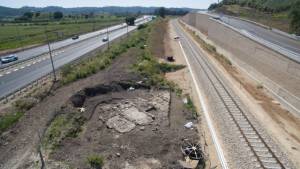The Land of Israel constantly reveals hidden treasures, testifying to its rich history. This time, archaeologists discovered an extraordinary 1,600-year-old glass production center in the north dating from the Roman era.

The kilns that were exposed next to the train tracks. (Assaf Peretz/IAA)
Israelis have again chanced upon an extraordinary archaeological discovery that was revealed at the foot of Mount Carmel during road construction in the north, exposing the oldest glass kilns found to date in Israel.
The oldest kilns in Israel produced commercial quantities of raw glass, which were sold throughout the Roman Empire. These kilns, about 1,600 years old and dating to the Roman period, indicate that the Israel was one of the foremost centers for glass production in the ancient world.
Glass production kilns that date to the sixth or early seventh century CE were previously found at Apollonia in Herzliya and other locations in Israel, but none were this old.
“This is a very important discovery with implications regarding the history of the glass industry both in Israel and in the entire ancient world,” said Yael Gorin-Rosen, head curator of the Israel Antiquities Authority (IAA) Glass Department. “We know from historical sources dating to the Roman period that the Valley of ‘Akko was renowned for the excellent quality sand located there, which was highly suitable for the manufacturing of glass. Chemical analyses conducted on glass vessels from this period, which were discovered until now at sites in Europe and in shipwrecks in the Mediterranean basin, have shown that the source of the glass is from our region. Now, for the first time, the kilns have been found where the raw material was manufactured that was used to produce this glassware”.
The excavation of the kilns has caused great excitement in recent weeks among glass researchers throughout the world, some of whom have traveled to Israel to get a first-hand look at the discovery.
According to Professor Ian Freestone of the University College London, who specializes in identifying the chemical composition of glass, “this is a sensational discovery and it is of great significance for understanding the entire system of the glass trade in antiquity. This is evidence that Israel constituted a production center on an international scale; hence its glassware was widely distributed throughout the Mediterranean and Europe”.
Another Chanced Archaeological Discovery
This enormously important site was discovered by chance last summer by archaeologist Abdel Al-Salam Sa‘id, an inspector with the IAA, while overseeing infrastructure work being conducted on the new railway line from Haifa to the east.
He found chunks of glass, a floor and an ash layer inside a trench. He halted construction work at the site and began preparations for an archaeological excavation, the important results of which are now evident.

Small fragments of the raw glass as they were found at the site. (Assaf Peretz/IAA)
“We exposed fragments of floors, pieces of vitrified bricks from the walls and ceiling of the kilns, and clean raw glass chips. We were absolutely overwhelmed with excitement when we understood the great significance of the finds,” Al-Salam Sa‘id said.
The kilns that were revealed consisted of two built compartments: a firebox where kindling was burnt to create a very high temperature, and a melting chamber – in which the raw materials for the glass, clean beach sand and salt, were inserted and melted together at a temperature of 1,200 C degrees. The glass was heated for a week or two until enormous chunks of raw glass were produced, some of which weighed in excess of ten tons. At the end of the manufacturing process the kilns were cooled; the large glass chunks that were manufactured were broken into smaller pieces and were sold to workshops where they were melted again in order to produce glassware.
During the early Roman period the use of glass greatly expanded due to its characteristics: its transparency, beauty, the delicacy of the vessels and the speed with which they could be produced by blowing – an inexpensive technique adopted at the time that lowered production costs.
Glass was used in almost every household from the Roman period onward, and it was also utilized in the construction of public buildings in the form of windows, mosaics and lighting fixtures. Consequently, large quantities of raw glass were required which were prepared on an industrial scale in specialized centers. The installation that was discovered in the excavation is an example of one of these ancient production facilities.
Judean Glass Source Revealed
According to a price edict circulated by the Roman emperor Diocletian in the early fourth century CE, there were two kinds of glass: the first was known as Judean glass, from the land Israel, and the second – Alexandrian glass, from Alexandria, Egypt.
Judean glass was a light green color and less expensive than Egyptian glass. The question until now centered around the origin of the manufacturer of Judean glass, which was a branded product known throughout the Roman Empire and whose price was engraved on stone tablets so as to ensure fair trade. This discovery completes the missing link in the research and reveals the location where the famous Judean glass was produced.
Researchers now hope that by means of its chemical composition they will be able to trace the export of the glass throughout the Roman Empire.
By: Max Gelber, United with Israel

Free Ebook: 10 Best Places to Visit in Israel
The Land of Israel has provided the backdrop for some of the most important events in human history. From the Old City in Jerusalem to the Sea of Galilee, people from all over the globe visit the Holy Land each year to take in the breathtaking scenery and inspiration of Israel. Now you can experience this beauty for yourself from the comforts of home and maybe plan a trip of your own to Israel. Get the free, exclusive eBook from United with Israel: The 10 Best Places to Visit in Israel.
Do You Love Israel? Make a Donation - Show Your Support!
Donate to vital charities that help protect Israeli citizens and inspire millions around the world to support Israel too!
Now more than ever, Israel needs your help to fight and win the war -- including on the battlefield of public opinion.
Antisemitism, anti-Israel bias and boycotts are out of control. Israel's enemies are inciting terror and violence against innocent Israelis and Jews around the world. Help us fight back!


